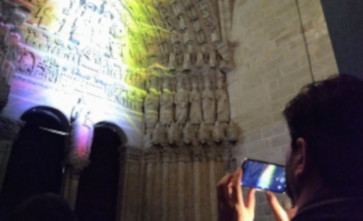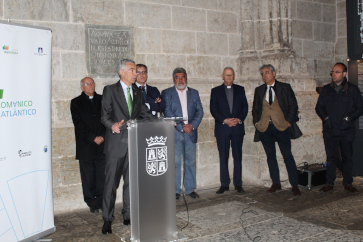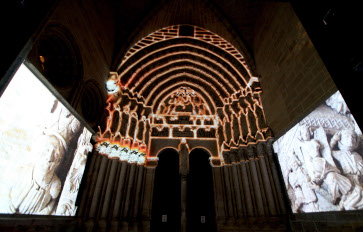
This work entailed forming aeration and drainage chambers to ensure any water was removed from the building.
Ciudad Rodrigo Cathedral was the backdrop for the presentation of the cloister restoration works undertaken by the Castilla y León Regional Government’s Ministry of Culture and Tourism and the official inauguration of the cathedral’s new information point in the Puerta del Perdón, which was designed within the remit of the Atlantic Romanesque Plan.
Both inaugurations were presided over by Castilla y León Regional Government’s general director of Cultural Heritage, Enrique Saiz and the chairman of Fundación Iberdrola España, Fernando García, who were accompanied by the Apostolic Administrator of the Diocese, Jesús García Burillo, and representatives from the Fundación Santa María la Real, the institutions involved in implementing the Atlantic Romanesque Plan.
The work carried out in the cloister throughout the past year involved the definitive restoration of the cathedral’s entire cloister space and annexed buildings. This has solved the persistent damp problems that affected it, which is an especially serious problem in the town due to the characteristics of the local sandstone. This work entailed forming aeration and drainage chambers to ensure any water was removed from the building. Furthermore, the roofs were renewed incorporating a construction solution that guarantees their watertightness.
In addition, the exterior façade, the cloister walls and walls of the chapel of San Jerónimo were cleaned and consolidated and all the original wooden doors were restored. All this has meant an investment by the Ministry of Culture and Tourism of over 1 million euros.
The works to create a new point to provide information on the Atlantic Romanesque in the cathedral fulfilled a double objective: to facilitate the preventive conservation of the building and to improve the provision and management of the information available. To achieve this, one of its most iconic spaces: the Puerta del Perdón, has been transformed into an information and visitor reception point. This involved the installation of an audiovisual and exhibition projection, which, as has been proved today, highlights the artistic and evangelical values of the Gothic portal. This goes a long way towards meeting the objectives of the Atlantic Romanesque project.
Preventive conservation
Another aspect to which the Plan has given special importance has been to facilitate the preventive conservation of the building by including it in the Fundación Santa María la Real’s heritage monitoring system (HMS). This involved installing a network of 36 control points, each equipped with different sensors and devices, which allows continuous online control of the cathedral’s status. The system’s managers are provided with precise information on parameters including temperature, humidity, light levels, solar radiation, CO² concentration and even a warning of the possible presence of wood boring insects.

El sistema de monitorización del patrimonio (MHS) servirá para obtener datos reales sobre su estado de conservación.
The monitoring carried out in the cathedral will provide real data on its conservation status and information on aspects such as, for example, whether the humidity detected in its floor slabs and coverings in the winter months is negatively affecting the building or its contents.
Several heated pews were installed in the Capilla del Sagrario. These will offer greater comfort to the faithful and people who visit the cathedral, encourage more efficient energy consumption and promote preventive conservation.
The project was co-financed by Fundación Iberdrola España and the Castilla y León Regional Government’s Ministry of Culture and Tourism to the tune of €300,000.
It’s fun to restore
Finally, a book entitled It’s Fun to Restore has been published in order to help people appreciate the value of their heritage and to make the Atlantic Romanesque Plan more accessible to the public. It is based on images from the cathedral and offers the youngest children different games and activities so they can understand, find out about and enjoy their heritage.
The cathedral
Ciudad Rodrigo Cathedral is dedicated to Nuestra Señora Santa María. Construction began in the 12th century and continued during the 13th and 14th centuries. What began as a late Romanesque project ended up as a large Gothic building with a Latin cross-shaped layout, three-apse sanctuary and transept. It has three portals all erected at different times, the Amayuelas door in the northern façade is from the 14th century, the Cadenas door has magnificent sculptural decoration and, at the foot of the cathedral, the Pórtico del Perdón or la Gloria, which now houses the information point. This is a smart enhancement of the Cathedral of Santa María, which this year commemorates the 130th anniversary of its declaration as a Cultural Heritage Site.
In addition, the general director has indicated that the Castilla y León Regional Government has supported the conservation of the cathedral with a large historical investment, which exceeds 5 million euros.

The project was co-financed by Fundación Iberdrola España and the Castilla y León Regional Government’s Ministry of Culture and Tourism to the tune of €300,000.
Documentation of the Atlantic Romanesque Intervention Plan
Definition of the Plan
The Atlantic-Romanesque Intervention Plan is a cross-border cultural heritage conservation cooperation project that involves restoring and revitalising twenty Romanesque churches located in the Spanish provinces of Zamora and Salamanca and in the Portuguese regions of Porto, Vila-Real and Bragança.
Goals
The Atlantic Romanesque Intervention Plan essentially seeks to preserve, restore and showcase heritage sites while laying the foundation for sustainable regional growth and development by creating employment, invigorating the social-economic landscape and promoting tourism.
Activities
Ever since it was first implemented, the Atlantic Romanesque Programme has been committed to going beyond the interventions themselves by undertaking R&D&i projects and creating research networks, which facilitate preventive conservation and the smart management of heritage assets.
In addition, a comprehensive cultural management plan has been developed covering the heritage sites, which includes educational, cultural and tourism projects interwoven with a network of synergies and collaborations. It contributes not only to promoting and providing information on the heritage assets, but also to the exchange of experiences and reinforcement of a common European identity.
Public-private sector initiative and budget
The Atlantic Romanesque Intervention Plan involves close collaboration between different organisations in Spain and Portugal, specifically the Castilla y León Regional Government’s Ministry of Culture and Tourism, the Portuguese Ministry of Culture, Iberdrola Spain, the Catholic Church in Portugal and the Spanish dioceses of Ciudad Rodrigo, Salamanca, Zamora and Astorga. This collaboration was embodied in the agreement-protocol signed in Bragança (Portugal) on 22 September 2010, which was recently extended to provide continuity until the end of 2019.
This public-private initiative began with an overall budget of 4.5 million euros, contributed by Fundación Iberdrola España, the Castilla y León Regional Government and the Portuguese Ministry of Culture. The works in Spain are overseen by the Fundación Santa María la Real del Patrimonio Histórico and carried out in constant collaboration with the bishoprics of the corresponding areas.
The parties involved
Fundación Iberdrola España. The foundation focuses its activity on four major areas of activity: education and research in the area of energy and the environment, support for biodiversity, cultural development in the areas where the Iberdrola Group operates and cooperation and solidarity. It also runs various projects to preserve historic and artistic heritage. In addition to the Atlantic Romanesque Intervention Plan, it also sponsors a major pioneering project in Spain: Lighting the Prado. Thanks to this sponsorship, each of the rooms in the prestigious Prado Museum now has new LED lighting, which has returned the works to natural lighting, reduced the number of fittings lighting the pieces over time and reduced expenditure on this formidable building’s energy use by a third. Similarly, another major initiative financed by Fundación Iberdrola España is designing the illumination of buildings that are important to our heritage, such as the interior of the church in the Monasterio de Yuso (La Rioja) and the Basilica of the Real Monasterio de El Escorial (Madrid).
Castilla y León Regional Government. The Romanesque Plan for Castile and Leon, which is managed by the regional government, is a comprehensive project going beyond simply restoring each church in its own right. In addition, it will also lay the foundations for sustainable economic growth, promote Romanesque heritage as a symbol of cultural identity and improve the region’s competitiveness in terms of tourism. Since 2005, the Department of Culture and Tourism has invested €26 million in the Romanesque heritage of the Castile and Leon region, carrying out work on 150 monuments within the framework of the Northern Romanesque, Romanesque Zamora, Romanesque Soria and the Atlantic Romanesque Plans. The Northern Romanesque Programme started in 2005 and is facilitating the comprehensive restoration and greater understanding of over fifty religious buildings in Palencia and the north of Burgos. Romanesque Soria began in 2007 in partnership with the Fundación Duques de Soria and the Diocese of Osma Soria and entails the restoration 35 monuments. Romanesque Zamora began in 2008 and has already been involved in 22 Romanesque churches in the city of Zamora. The Atlantic Romanesque Plan is facilitating the restoration and maintenance of over twenty medieval churches in Spain and Portugal. The last Plan of this type to have been launched is the Mudéjar Romanesque Plan, which mainly covers the south of the autonomous region, in the provinces of Segovia, Ávila and Valladolid, as well as some churches in Salamanca.
Portuguese Ministry of Culture. The Ministry of Culture is one of the Portuguese governmental departments assigned the task of implementing a comprehensive and coordinated policy on cultural matters. Its mission is to help improve public access to culture and defend, safeguard and promote cultural heritage by encouraging new forms of knowledge. It is also responsible for providing the infrastructure required to implement a coherent, solid and efficient cultural policy and it is open to considering and supporting civil initiatives. Furthermore, the ministry stimulates cooperation with autonomous and regional agencies as well as with cultural agents from the private sector.
The Fundación Santa María la Real del Patrimonio Histórico is a private charitable organisation based in Castilla y León whose main mission is to promote sustainable development initiatives based on studying, researching, restoring, conserving and encouraging a wider understanding of social, natural and cultural heritage.
